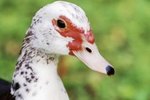Things You'll Need
Brooding pen
Pen
Coop
Heat lamp
Feed
Water fountain
Warnings
Observe your birds carefully for nose, toe, feather or other picking. Any pheasant that has been picked should be removed from the pen and kept isolated until the wounds are healed.
Tips
Do not overcrowd pheasants. Overcrowding can cause feather picking and other health problems. Give them lots of room.
Pheasants molt their juvenile plumage at seven weeks of age. Tail picking can become a problem at this time
Pheasants were first introduced into the U.S. from Asia about 130 years ago. They are popular and colorful game birds of many different varieties. Named after their specific native homelands in Asia, pheasant varieties include the most common, the Chinese ringneck; the domesticated Golden; and the Mongolian, Szechwan, and Japanese. With the proper housing, feed and care, pheasants can be raised successfully on any small farm.
Prepare the brooding pen properly. It must be cleaned, disinfected, and well-constructed to prevent drafts and predators from entering. It must have no cracks, holes or loose boards.
Remove pheasant chicks from their shipping container upon arrival at your farm. Dip their beaks in water and put them under the heat lamp. Venting the brooder house to maintain a room temperature between 70-80 degrees Fahrenheit will ensure a good growing environment
Inspect the chicks often during the first week – especially at night during the first few nights.
After the chicks are a few weeks old, allow them to range outside during the daytime. The pen should be large enough to allow one to two square feet per bird. Drive the chicks back into the house late each afternoon.
After the birds are four to five weeks old move them to a larger pen that is covered, usually with a polypropylene top netting. Uncovered pens will be a problem, since the more mature birds can easily fly away.
Feed your birds with commercially mixed and prepared feed especially for pheasants. This will provide the right amount of protein necessary for the various growing stages. After the birds are six weeks old they can be fed a 20 percent protein grower feed.
Replace the water in your fountain twice daily and clean the units to help prevent disease. Water is the most important requirement of young pheasants. Cool, clean water should be available at all times.
References
Photo Credits
-
Jupiterimages/Photos.com/Getty Images





